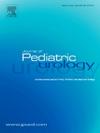患有肛肠畸形的儿童患慢性肾脏疾病的风险增加。
IF 1.9
3区 医学
Q2 PEDIATRICS
引用次数: 0
摘要
背景:肛肠畸形(ARM)常伴有泌尿系统异常,这可能导致慢性肾脏疾病(CKD)的发展。目的:本研究旨在探讨ARM患儿肾脏、尿路异常及膀胱功能障碍的患病率及其对CKD发展的潜在影响。研究设计:这项单中心、回顾性研究包括175名ARM患儿,排除了75名数据缺失的患儿。临床和放射学表现及血清肌酐水平均来自医疗记录。根据Wingspread分类将肛管直肠畸形分为“高”型和“低”型,并根据Krickenbeck国际分类进一步按瘘型和性别分布进行分类。CKD是根据KDIGO(肾脏疾病改善全球结局)指南定义和分期的。结果:患者中位年龄为9.7岁,男女比例为1.13:1。175例患者中,97例(55%)为中低型ARM, 78例(45%)为高型ARM。85例患者(48.5%)发现肾脏和/或尿路异常,其中63例为肾脏异常,71例为尿路异常。最常见的尿路异常是膀胱输尿管反流(n = 58)。膀胱功能障碍56例(32%)。30例(17%)患者被诊断为CKD;5期6例,2 ~ 4期24例。CKD的发展在患有肾脏异常的女性和男性中都更为常见(p讨论:本研究强调,大约一半的ARM儿童患有肾脏和尿路异常,三分之一患有膀胱功能障碍。此外,近五分之一的患者发展为CKD,主要是在早期阶段。我们的研究结果还表明,肾脏异常和膀胱功能障碍是ARM患儿CKD发展的重要危险因素。结论:本研究强调肾脏异常和膀胱功能障碍是CKD的危险因素。医生应注意监测和管理这些风险,以尽量减少对ARM儿童肾脏健康的长期影响。本文章由计算机程序翻译,如有差异,请以英文原文为准。
Increased risk of chronic kidney disease in children with anorectal malformations
Background
Anorectal malformations (ARM) are often accompanied by urological anomalies, which can contribute to the development of chronic kidney disease (CKD).
Objective
This study aimed to investigate the prevalence of kidney and urinary tract anomalies, as well as bladder dysfunction, and their potential impact on the development of CKD in children with ARM.
Study design
This single-center, retrospective study included 175 children with ARM, after excluding 75 children with missing data. Clinical and radiological findings and serum creatinine levels were obtained from medical records. Anorectal malformations were classified as “high” and “low” type based on the Wingspread classification, and also further classified by fistula type and sex distribution according to the Krickenbeck International Classification. CKD was defined and staged according to the KDIGO (Kidney Disease Improving Global Outcomes) guidelines.
Results
The median age of the patients was 9.7 years, with a male-to-female ratio of 1.13:1. Among the 175 patients, 97 (55 %) had intermediate or low-type ARM, and 78 (45 %) had high-type ARM. Kidney and/or urinary tract anomalies were identified in 85 patients (48.5 %), with 63 having kidney anomalies and 71 having urinary tract anomalies. The most common urinary tract anomaly was vesicoureteral reflux (n = 58). Bladder dysfunction was observed in 56 patients (32 %). CKD was diagnosed in 30 patients (17 %); six of them were in CKD stage 5, and the remaining 24 were in stages 2–4. The development of CKD was more common in both females and males with kidney anomalies (p < 0.001), urinary tract anomalies (p < 0.001 and p = 0.002, respectively), bladder dysfunction (p < 0.001), urinary tract infection (p < 0.001), in addition females with persistent cloaca (p = 0.023) and spinal anomalies (p = 0.013). Kidney anomalies and bladder dysfunction were independently associated with the development of CKD (p < 0.001 and p = 0.046, respectively).
Discussion
This study highlights that approximately half of the children with ARM had kidney and urinary tract anomalies, and one-third had bladder dysfunction. Additionally, almost one-fifth of the patients developed CKD, mostly in the early stages. Our findings also suggest that both kidney anomalies and bladder dysfunction are significant risk factors for CKD development in children with ARM.
Conclusion
This study emphasizes the presence of kidney anomalies, along with bladder dysfunction as risk factors for CKD. Physicians should take care to monitor and manage these risks to minimize the long-term impacts on kidney health in children with ARM.
求助全文
通过发布文献求助,成功后即可免费获取论文全文。
去求助
来源期刊

Journal of Pediatric Urology
PEDIATRICS-UROLOGY & NEPHROLOGY
CiteScore
3.70
自引率
15.00%
发文量
330
审稿时长
4-8 weeks
期刊介绍:
The Journal of Pediatric Urology publishes submitted research and clinical articles relating to Pediatric Urology which have been accepted after adequate peer review.
It publishes regular articles that have been submitted after invitation, that cover the curriculum of Pediatric Urology, and enable trainee surgeons to attain theoretical competence of the sub-specialty.
It publishes regular reviews of pediatric urological articles appearing in other journals.
It publishes invited review articles by recognised experts on modern or controversial aspects of the sub-specialty.
It enables any affiliated society to advertise society events or information in the journal without charge and will publish abstracts of papers to be read at society meetings.
 求助内容:
求助内容: 应助结果提醒方式:
应助结果提醒方式:


